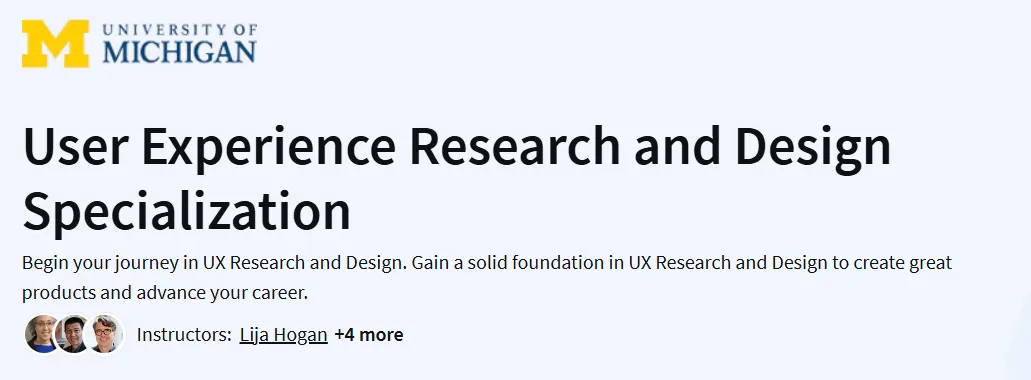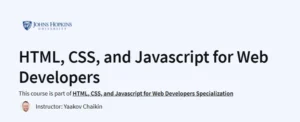What you will learn in User Experience Research and Design Specialization
Understand the basics of UX design and UX research.
Use appropriate UX research approaches to inform design decisions.
Design a complete product, taking it from an initial concept to an interactive prototype.
Apply user-centered design principles to create effective and engaging user experiences.
Program Overview
Introduction to User Experience Principles and Processes
⏳ 11 hours
- Gain an understanding of the fields of UX design and UX research. Learn design principles and best practices based on human capabilities and behavior. Incorporate a user-centered focus into the design process
Understanding User Needs
⏳ 10 hours
- Learn about user needs assessments and qualitative research. Explore methodologies for qualitative research, including semi-structured interviews, in-situ observation, and affinity walls.
Evaluating Designs with Users
⏳ 8 hours
- Identify different approaches to user testing and their appropriate use. Design and run user tests effectively. Analyze and report on user testing results.
UX Design: From Concept to Prototype
⏳ 15 hours
- Define and scope design problems. Create user stories and storyboards to transform information about user needs into design concepts. Develop prototypes from elements of interactions and low-to-high fidelity mockups.
UX Research at Scale: Surveys, Analytics, Online Testing
⏳ 18 hours
- Understand survey methodology from the UX perspective. Learn techniques for gaining UX insights from large numbers of users, including web analytics, A/B testing, and remote unmoderated studies.
UX (User Experience) Capstone
⏳ 20 hours
- Conduct a multi-stage user experience project to design a product from scratch. Employ interviews, inspection methods, and user testing, along with ideation, design, and prototyping methods to gain and communicate valuable insights.
Get certificate
Job Outlook
Completing this specialization prepares you for roles such as UX Designer, UX Researcher, or Interaction Designer.
The skills acquired are applicable across various industries that utilize user-centered design practices.
Enhance your employability by gaining practical experience in UX research and design.
Specification: User Experience Research and Design Specialization
|
FAQs
- No prior UX or design experience is required.
- Basic computer skills are sufficient.
- The course introduces concepts from scratch.
- Emphasis is on hands-on learning rather than theory alone.
- Creativity and curiosity are more important than technical expertise.
- Yes, you’ll work on projects from concept to prototype.
- Includes user research, wireframes, and interactive prototypes.
- Projects can be showcased to potential employers.
- Covers both individual and collaborative design processes.
- Additional portfolio work is encouraged for maximum impact.
- UX design principles are valuable in almost any sector.
- Applicable in healthcare, finance, education, and e-commerce.
- User-centered design improves product adoption and satisfaction.
- Skills help in both physical and digital product design.
- Companies increasingly value UX research for decision-making.
- Covers user research methods and design processes commonly discussed in interviews.
- Provides experience creating case studies for portfolios.
- Teaches problem-solving and analytical thinking skills.
- Familiarizes learners with UX tools and documentation practices.
- Additional interview-specific preparation is recommended.
- Conduct user interviews and usability testing for personal projects.
- Participate in online UX challenges or hackathons.
- Volunteer for non-profits to design meaningful user experiences.
- Explore UX design tools like Figma, Sketch, or Adobe XD.
- Document your design decisions and process in a personal UX journal.





